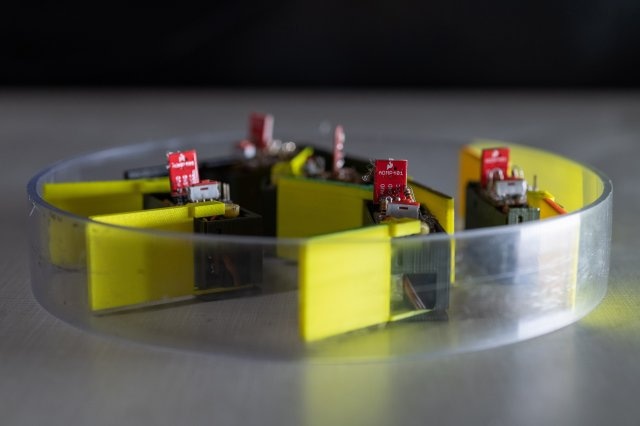Sep 19 2019
A U.S. Army study used a new method to produce robots—scientists developed robots solely from tiny robots called smarticles, revealing the principles of a potentially new movement method.
 Five identical “smarticles”—smart active particles—interact with one another in an enclosure. By nudging each other, the group—dubbed a “supersmarticle”—can move in random ways. The research could lead to robotic systems capable of changing their shapes, modalities, and functions. (Image credit: Rob Felt, Georgia Tech)
Five identical “smarticles”—smart active particles—interact with one another in an enclosure. By nudging each other, the group—dubbed a “supersmarticle”—can move in random ways. The research could lead to robotic systems capable of changing their shapes, modalities, and functions. (Image credit: Rob Felt, Georgia Tech)
Scientists from Northwestern University and Georgia Institute of Technology have reported their results in Science Robotics.
Sam Stanton, program manager, complex dynamics and systems, at the Army Research Office, an element of U.S. Army Combat Capabilities Development Command’s Army Research Laboratory, the Army’s corporate research laboratory, said that the study outcomes could help produce robotic systems possessing the ability to change their shapes, functions, and modalities.
He said, “For example, as envisioned by the Army Functional Concept for Maneuver, a robotic swarm may someday be capable of moving to a river and then autonomously forming a structure to span the gap.”
The 3D-printed smarticles, or smart active particles, could only flap their two arms. However, if five of these smarticles are bound in a circle, they start to interact with each other, forming a robophysical system called a “supersmarticle” that is capable of moving by itself. The addition of a sound or light sensor facilitates the supersmarticle to move in response to the stimulus, as well as be controlled quite well to maneuver through a maze.
The concept of producing robots from tiny robots—and leveraging the group abilities that emerge by uniting individuals—could offer mechanically based control over very tiny robots. Eventually, the emergent behavior of the group could offer a new movement and control approach for small robots that are likely capable of changing shapes.
These are very rudimentary robots whose behavior is dominated by mechanics and the laws of physics. We are not looking to put sophisticated control, sensing and computation on them all. As robots become smaller and smaller, we’ll have to use mechanics and physics principles to control them because they won’t have the level of computation and sensing we would need for conventional control.
Dan Goldman, Study Principal Investigator and Dunn Family Professor, School of Physics, Georgia Institute of Technology
A study of construction staples is the basis for the study. By pouring these strong staples into a container with removable sides, Nick Gravish, former doctoral student and currently a faculty member at the University of California San Diego, was able to develop structures that could stand by themselves following the removal of the walls of the container.
The agitation of the staple towers gradually induced them to collapse, but the observations led to an understanding that simple entangling of mechanical objects could develop structures with capacity well beyond those of the single components.
Dan Goldman’s research is identifying physical principles that may prove essential for engineering emergent behavior in future robot collectives as well as new understanding of fundamental tradeoffs in system performance, responsiveness, uncertainty, resiliency and adaptivity.
Sam Stanton, Program Manager, Complex Dynamics and Systems, U.S. Army CCDC Army Research Laboratory
Using a 3D printer, the scientists developed battery-powered smarticles, containing simple sensors, motors, and restricted computing power. The devices could alter their position only when they hit other devices when surrounded by a ring.
“Even though no individual robot could move on its own, the cloud composed of multiple robots could move as it pushed itself apart and shrink as it pulled itself together,” remarked Goldman. “If you put a ring around the cloud of little robots, they start kicking each other around and the larger ring—what we call a supersmarticle—moves around randomly.”
The scientists observed that when one tiny robot stopped moving, probably because of low battery, the group of smarticles would start moving in the direction of that stuck robot. The scientists were able to control the movement by introducing photo sensors into the robots that can stop the arm flapping when a powerful beam of light strikes one of them.
If you angle the flashlight just right, you can highlight the robot you want to be inactive, and that causes the ring to lurch toward or away from it, even though no robots are programmed to move toward the light. That allowed steering of the ensemble in a very rudimentary, stochastic way.
Dan Goldman, Study Principal Investigator and Dunn Family Professor, School of Physics, Georgia Institute of Technology
As part of future studies, Goldman visualizes further complicated interactions that use the simple sensing and movement capabilities of the smarticles. “People have been interested in making a certain kind of swarm robots that are composed of other robots,” he stated. “These structures could be reconfigured on demand to meet specific needs by tweaking their geometry.”
Formations of swarms of robotic systems could be used to improve situational awareness and mission-command capabilities for small military units in difficult-to-navigate environments such as forests, cities, caves, or other rough ground.
The study was financially supported by the National Science Foundation.
Smarticles: Robots Built from Smaller Robots Work Together
(Video credit: U.S. Army CCDC Army Research Laboratory)